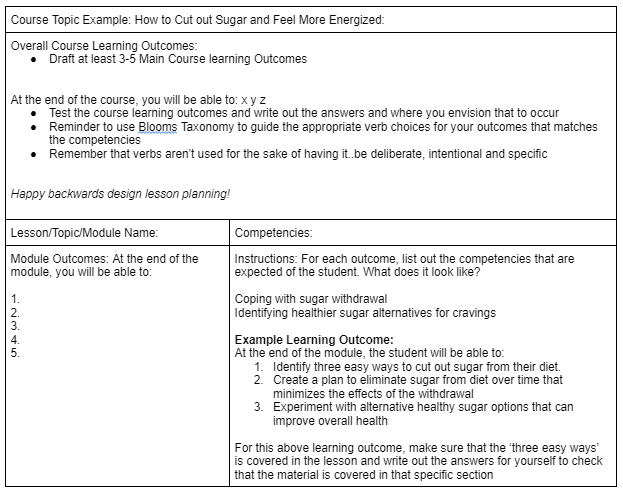When we first begin the process of building our online course, we are overwhelmed by all the different ways to begin the process. We know the content so well and have taught the material many times but suddenly we get stuck when planning the course.
This is where backward design lesson planning comes in handy – as an instructional design model that helps you cut through the overhwelming task of creating a lesson plan that designing a course based on learner’s neads.
Begin with the end in mindDr. Stephen R. Covey
Jump ahead:
- What is Backwards Design?
- Traditional Design Approach
- Benefits of Backwards Design
- 5 Steps to Backward Design
- Backward Design Lesson Plan Template
Or grab them here for google docs or word!
![]()
![]()
What is Backwards Design?
The idea behind backwards design is simply starting from the outcome or end result that you’d like your students to experience and build the modules/chapters/sections one by one with the outcomes guiding the process. This approach helps define the results that your learners can expect from each section and or chapter and helps you. By focusing on the results, you will deliver a better learning experience by showing the path to the transformation promised to them.
Traditional Design Approach
If you’ve never heard of backwards design or see it being used then it is because most of the time people are using a traditional approach. The traditional design approach is the exact opposite- the process starts at the front and works its way to the end.
For example, if I’m planning a curriculum for losing weight by cutting out sugar, my first step would be to plan out the course curriculum by listing out all the topics related to the subject matter. Then the next step is to bring in the various lessons that fit the topic so that I’m breaking down the topic into sub-topics. Finally, the last step is to develop assignments and or quizzes to evaluate student’s grasp of the material. The challenge with this approach is that traditional design overlooks and neglects the course outcomes and how a student might achieve them resulting in lackluster results and engagement.
One cannot plan curriculum and build learning products without clearly defining the expectations and outcomes for our students. This happens too often and students experience the disconnect between the material and their results feeling lost and or confused because the expectations do not match up.
At the same time, the other disadvantage of traditional lesson planning is that the process ignores the learner’s needs and role throughout the curriculum design process. Given this context on the traditional design process, backwards design is a much more practical and effective framework to help course creators design an engaging learning experience that makes an impact for the learners and their business.
Related: The Ultimate List of Free Online Course Lesson Plan Templates
Benefits of Backwards Design
The benefits of backwards design is that each module/chapter sets the stage for the next and clearly shows the learner where they’re headed on their learning journey. This approach also delivers a more impactful and engaging learning experience that is intentional, focused and centered around the learner/student and their needs.
This is done by incorporating different learning modalities and styles into the design process to ensure that engagement is high. Since each person learns and experiences learning differently, it is our responsibility to deliver learning experiences that tap into the various learning styles and preferences that can increase the impact and transformation for our learner.
Last, the other added benefit of backwards design is that helps you as the instructor lead your students on the journey and show them the skills and knowledge they will master in a clearly defined roadmap.
5 Steps to Backward Design
Step 1:
The first step in beginning to use and incorporate backwards design is to identify the overall course outcomes, not objectives for your learners. One of the best ways to do this is by listing and or writing out outcomes using Bloom’s Taxonomy.
For many of us, it is not easy to write this so go for the practice of writing out the outcomes regardless of whether they are accurate. You want to treat writing learning outcomes as an iterative process so that you get better and better at it over time.
Now that we’ve distinguished the definition and differences of outcomes vs objectives, we can proceed with the design process by identifying and applying appropriate learning outcomes that match the expectations and skills to be mastered by the student.
The purpose behind Blooms Taxonomy is to help us guide our students from learning to acquire new knowledge to more concrete and higher levels of mastery such as application, analysis, critical thinking and evaluation.
People don’t buy online courses for fun or to gain new knowledge, they buy online courses and learn from you to experience a transformation whether that be a healthier lifestyle, weight loss, or acquire skills to uplevel in their job. As a result, Blooms Taxonomy guides the lesson planning and helps us frame each lesson with clarity, purpose, and specificity that sets clear expectations.
Step 2:
Once you’ve identified the course learning outcomes, now you will write out (see template for example) the competencies and skills that they will achieve from those outcomes and what that looks like. For instance, is it mastering the sugar cravings or withdrawal feelings or is it skillfully practicing exercises that change the way we experience withdrawal or cravings?
Step 3:
Now once we’ve done those two steps, lets compare them side by side to see if they match the content that we are bringing in. If you feel that the content in the chapter doesn’t reflect the outcomes, then cut it out and put it in a separate document so that you have it later on.
Is this important for my course design? Yes!
Why?
One of the many reasons why learning outcomes is more preferred over learning objectives is because the word ‘outcomes’ is more focused on a tangible and specific skill and or task while ‘objectives’ is something we intend for the learner to accomplish.
Step 4:
Now that you’ve identified the outcomes and competencies for the course, repeat the process for the next modules/chapters in your course. Rinse and repeat and then go back to the beginning to review and have someone else to employ a fresh lens and perspective and check that its accurate.
Step 5:
Once you’re satisfied and have done your due diligence, celebrate and get excited for your learners to experience the transformation from all the hard work, effort and time you put into centering the course around the learning outcomes that takes into account the wide variety of ways individuals learn and engage online.
Backward Design Lesson Plan Template
You can use this backwards design lesson plan template as a head start!

In conclusion, backwards design planning is a different approach for many of us and will challenge how we traditionally design and build courses by starting with the end goal in mind.
This practice will take time to adapt to this approach but will get easier over time as we begin to identify and see the difference when the outcomes match up with the course design and learning experience. The benefit and results for your learners will lead to a more positive and rewarding online learning experience.
Backwards design is one of many instructional design models you can use to create your course, get the full list here!








